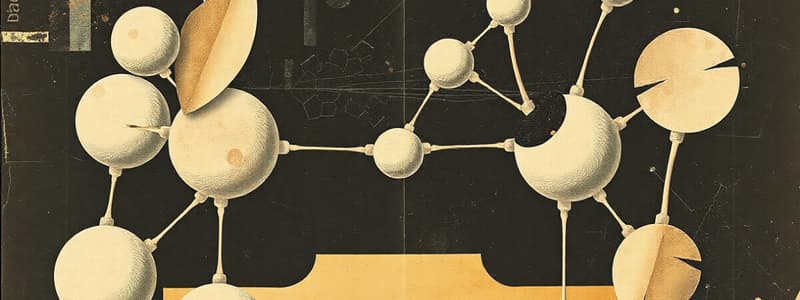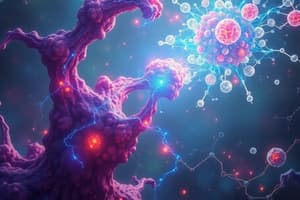Podcast
Questions and Answers
What is the name of a branched group composed of one carbon?
What is the name of a branched group composed of one carbon?
- Methyl group (correct)
- Ethyl group
- Propyl group
- Butyl group
In the naming of substituent groups, what is the correct suffix used for alkyl groups?
In the naming of substituent groups, what is the correct suffix used for alkyl groups?
- ane
- ylo
- yl (correct)
- ine
Which of the following correctly describes how to number the carbon chain in a molecule?
Which of the following correctly describes how to number the carbon chain in a molecule?
- Number to give the substituent the highest possible number
- Start numbering from the end closest to a substituent to give it the lowest possible number (correct)
- Start from the left side to give the highest numbers to substituents
- Number in any order, it does not affect the name
What is the name of the longest continuous chain identified in a molecule with five carbons and only single bonds?
What is the name of the longest continuous chain identified in a molecule with five carbons and only single bonds?
If a substituent group is located on carbon number 2 in a four-carbon chain, how would the compound be named?
If a substituent group is located on carbon number 2 in a four-carbon chain, how would the compound be named?
What is the angle between the sp2 hybridised orbitals?
What is the angle between the sp2 hybridised orbitals?
Which type of bond is formed by the 'sideways' or 'collateral' overlapping of unhybridised p-orbitals?
Which type of bond is formed by the 'sideways' or 'collateral' overlapping of unhybridised p-orbitals?
What is the main difference between sp2 and sp1 hybridisation?
What is the main difference between sp2 and sp1 hybridisation?
What is the designation of the methyl group in 2-methylcyclohexanol?
What is the designation of the methyl group in 2-methylcyclohexanol?
Which of the following statements about sp2 hybridisation is incorrect?
Which of the following statements about sp2 hybridisation is incorrect?
Which hybridisation is associated with the formation of a triple bond?
Which hybridisation is associated with the formation of a triple bond?
What distinguishes isomers from one another?
What distinguishes isomers from one another?
Which type of isomerism involves atoms arranged in a completely different order?
Which type of isomerism involves atoms arranged in a completely different order?
What is a characteristic of chain isomers?
What is a characteristic of chain isomers?
Which molecule illustrates an example of positional isomerism?
Which molecule illustrates an example of positional isomerism?
In organic chemistry, what does the term 'stereo isomers' refer to?
In organic chemistry, what does the term 'stereo isomers' refer to?
Which notation is used to show the 3D arrangement of groups around a carbon atom?
Which notation is used to show the 3D arrangement of groups around a carbon atom?
What is the correct name for the compound discussed?
What is the correct name for the compound discussed?
What is the longest continuous carbon chain in the compound?
What is the longest continuous carbon chain in the compound?
What indicates that there is a carbon atom at the junction of two bonds in a skeletal formula?
What indicates that there is a carbon atom at the junction of two bonds in a skeletal formula?
How many groups are attached to the longest chain in this case?
How many groups are attached to the longest chain in this case?
Which of the following statements is true regarding the bonding in carbon?
Which of the following statements is true regarding the bonding in carbon?
What type of bonds are present in the longest carbon chain of this compound?
What type of bonds are present in the longest carbon chain of this compound?
What is the effect of removing hydrogen atoms from carbon chains in skeletal formulas?
What is the effect of removing hydrogen atoms from carbon chains in skeletal formulas?
What would the presence of a carbon atom at the end of a bond indicate in a skeletal formula?
What would the presence of a carbon atom at the end of a bond indicate in a skeletal formula?
Flashcards
sp2 Hybridisation
sp2 Hybridisation
The process where one s orbital and two p orbitals mix to form three equivalent sp2 orbitals, leaving one p orbital unchanged.
Planar Structure of sp2 Orbitals
Planar Structure of sp2 Orbitals
sp2 orbitals are arranged in a plane with 120° angles between them.
Sigma (σ) Bond
Sigma (σ) Bond
A bond formed by the head-on overlapping of orbitals, experienced in sp2 hybridisation.
Pi (π) Bond
Pi (π) Bond
Signup and view all the flashcards
sp1 Hybridisation
sp1 Hybridisation
Signup and view all the flashcards
Butane
Butane
Signup and view all the flashcards
Alkyl group
Alkyl group
Signup and view all the flashcards
Methyl
Methyl
Signup and view all the flashcards
Numbering chains
Numbering chains
Signup and view all the flashcards
2-methylbutane
2-methylbutane
Signup and view all the flashcards
3-ethyl-2,5-dimethylhexane
3-ethyl-2,5-dimethylhexane
Signup and view all the flashcards
Longest continuous chain
Longest continuous chain
Signup and view all the flashcards
Skeletal formula
Skeletal formula
Signup and view all the flashcards
Functional groups
Functional groups
Signup and view all the flashcards
Hexane
Hexane
Signup and view all the flashcards
Substituents
Substituents
Signup and view all the flashcards
Carbon bonds
Carbon bonds
Signup and view all the flashcards
IUPAC naming
IUPAC naming
Signup and view all the flashcards
Substituent Group
Substituent Group
Signup and view all the flashcards
2-Methylcyclohexanol
2-Methylcyclohexanol
Signup and view all the flashcards
3-D Arrangement
3-D Arrangement
Signup and view all the flashcards
Isomerism
Isomerism
Signup and view all the flashcards
Structural Isomers
Structural Isomers
Signup and view all the flashcards
Chain Isomers
Chain Isomers
Signup and view all the flashcards
Positional Isomers
Positional Isomers
Signup and view all the flashcards
Study Notes
Organic Chemistry
- Organic chemistry is the study of carbon compounds, including sugars, carbohydrates, and fats, used by living organisms.
- Carbon has six electrons, meaning it has an electron configuration of 1s²2s²2p².
- Carbon can form four covalent bonds due to hybridization.
- Hybridization is a process where the shapes of outer shell orbitals rearrange for more stable bonds in product molecules.
- Depending on the reaction, carbon can undergo three types of hybridization (sp³, sp², and sp).
Sp³ Hybridization
- The s orbital and three p orbitals of carbon combine to form four sp³ hybridized orbitals.
- These orbitals have a tetrahedral shape with bond angles of 109.5°.
- Sp³ orbitals typically bond with other hybridized orbitals or s orbitals through head-on or collinear overlapping, forming a sigma (σ) bond.
Sp² Hybridization
- The s orbital and two p orbitals of carbon combine to form three sp² hybridized orbitals.
- These orbitals are planar with bond angles of 120°.
- One p orbital remains unchanged and overlaps sideways or collaterally with another hybridized or s orbital, forming a pi (π) bond.
- This configuration forms a double bond.
Sp Hybridization
- The s orbital and one p orbital of carbon combine to form two sp hybridized orbitals.
- These orbitals are linear with bond angles of 180°.
- Two p orbitals remain unchanged, overlapping sideways to form two pi (π) bonds.
- This configuration forms a triple bond.
Homologous Series
- A homologous series is a group of compounds with similar structural features, differing by a -CH₂- unit.
- Members share similar chemical behaviors and physical properties.
- They often have a functional group responsible for characteristic reactions.
- Each homologous series has a class name distinct from its functional group.
- Examples include alkanes, alkenes, alkynes, alcohols, etc.
Naming Organic Compounds
- Compounds can be named using common names or systematic names (IUPAC).
- Common names may not provide structural information, while systematic names use rules based on the structure.
- Systematic names include prefixes for the number of carbon atoms and suffixes based on the homologous series.
Isomerism
- Isomers are molecules with the same molecular formula but different spatial arrangements of atoms.
- Structural isomers have different atom bonding orders.
- Stereoisomers have the same atom bonding order but different spatial arrangements.
- Geometric isomers have restricted rotation around a double bond, leading to cis and trans forms.
- Optical isomers are non-superimposable mirror images (enantiomers).
- A chiral molecule has a non-superimposable mirror image.
- Optical activity is the ability of a chiral substance to rotate plane-polarized light.
Studying That Suits You
Use AI to generate personalized quizzes and flashcards to suit your learning preferences.



